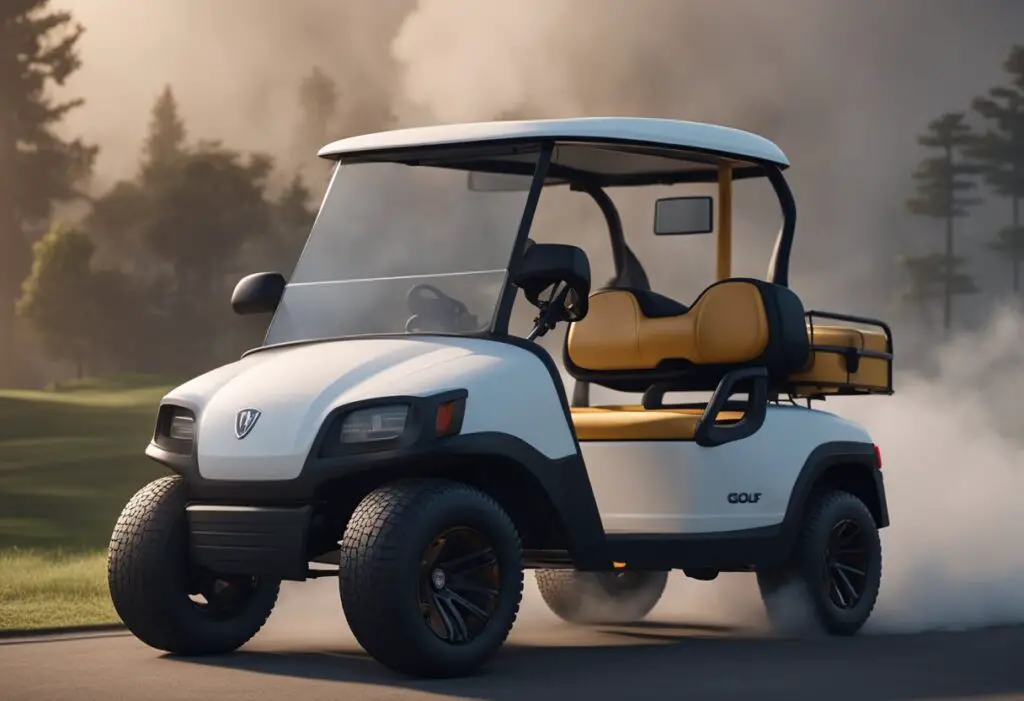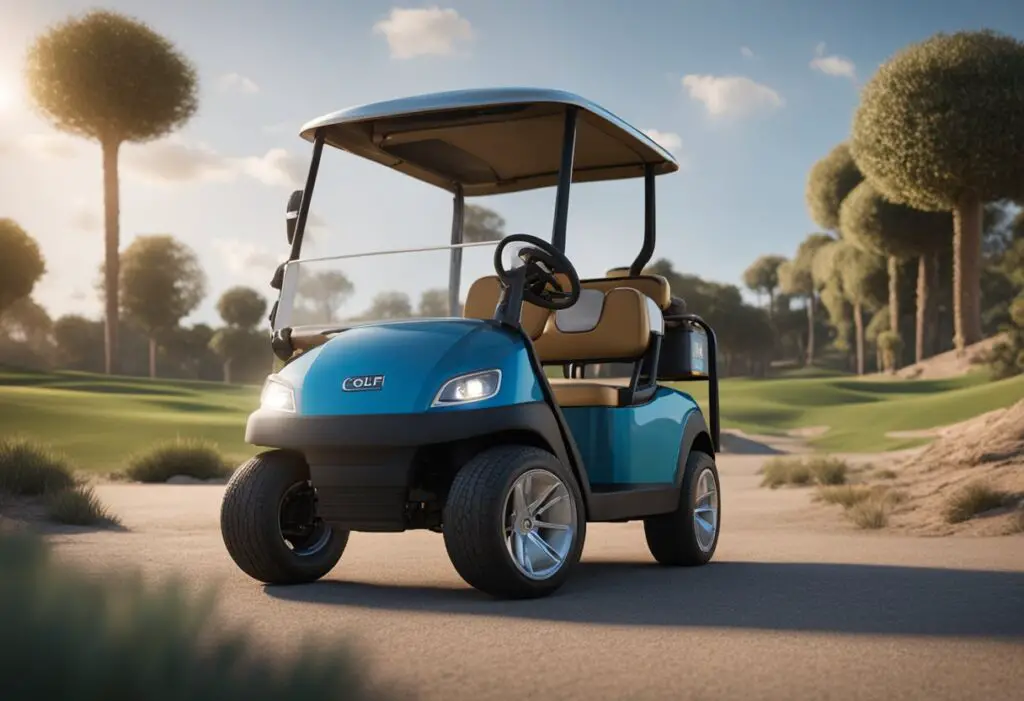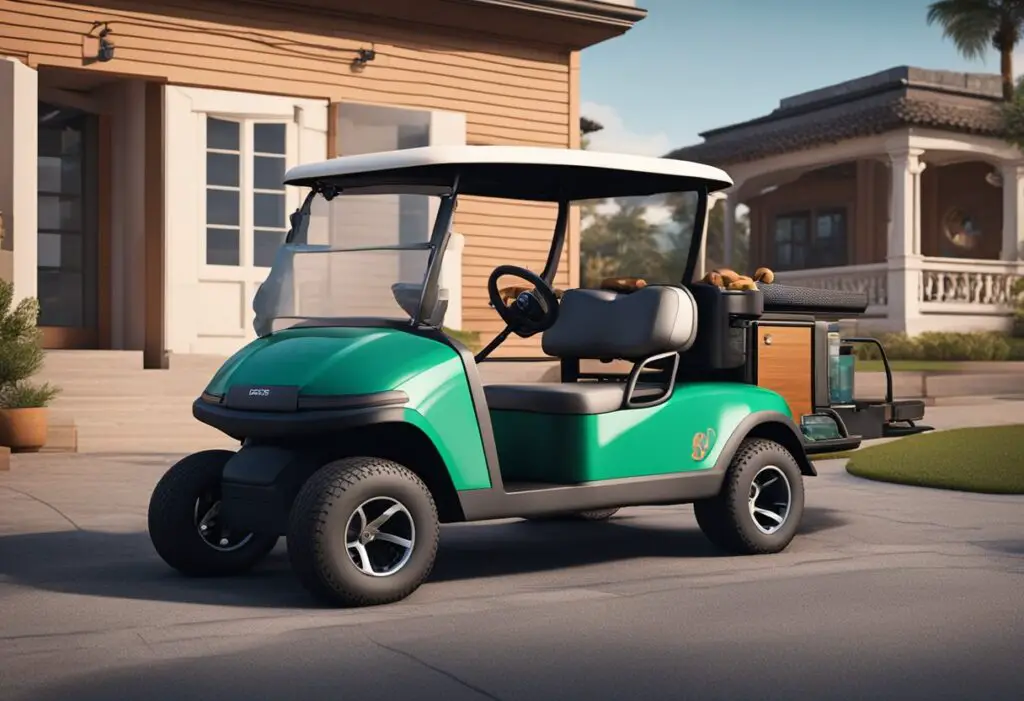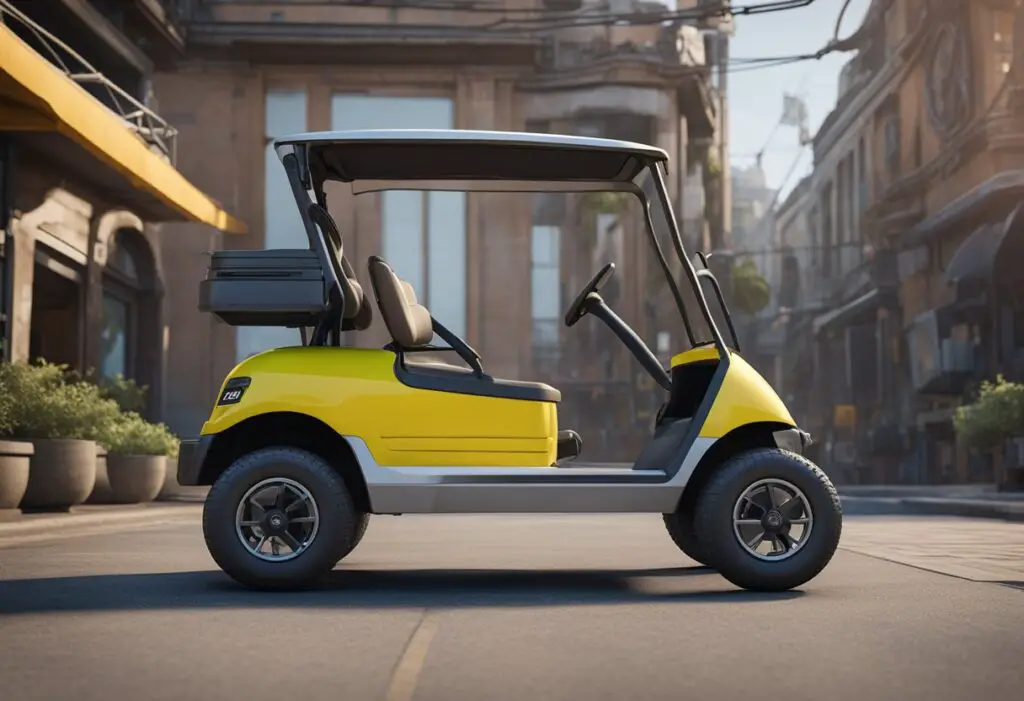Electric golf carts are a staple on the course, offering a convenient and eco-friendly means of transportation. However, like any vehicle, they can experience various issues that affect performance and functionality. Understanding common problems can greatly enhance your experience and extend the life of your cart.

Battery issues are the most prevalent, often manifesting as power shortages or an inability to hold a charge. Proper maintenance, including regular charging and water top-ups, is essential. Electrical problems such as faulty ignitions, motor issues, or malfunctioning solenoids can also arise, potentially causing the cart to stop abruptly or fail to start.
Key Takeaways
- Regular battery maintenance increases reliability.
- Troubleshooting electrical issues enhances cart performance.
- Understanding common problems supports long-term cart efficiency.
Understanding Electric Golf Cart Basics
Before jumping into troubleshooting your electric golf cart, it’s key to get familiar with its basic structure and functionality.
Components of an Electric Golf Cart
Batteries: Your golf cart’s power source, typically comprising six deep-cycle lead-acid batteries, combined to form a 36 or 48-volt system.
Motor: Electric golf carts have a single, electric motor that uses the direct current (DC) from the batteries to generate motion.
Controller: Acts as the brain of your cart, dictating the speed and acceleration by regulating the power flow from the batteries to the motor.
Solenoid: This is the primary contactor that connects and disconnects the battery’s current to the controller when you press the accelerator pedal.
Speed Controller: Allows you to set how fast you want your cart to travel, influencing the current sent to the motor.
Ignition: The physical key or button start that activates the electrical system.
How Electric Golf Carts Work
When you turn on your ignition, electricity flows from the batteries to the motor. The controller then steps in to determine how much power the motor should receive, which you can influence through the speed controller. Pressing the accelerator pedal activates the solenoid, further allowing electricity to move into the motor and set your golf cart in motion.
Remember, regular maintenance of these components is essential for ensuring the longevity and reliability of your electric golf cart. Keep an eye on your electrical system to enjoy a seamless golf cart experience.
Maintenance Essentials
Proper maintenance of your electric golf cart ensures reliability and longevity. It’s important to pay attention to cleaning, battery care, and connections to prevent common issues like power loss and corrosion.
Cleaning and Care
Start by keeping your golf cart clean. Use a mild soap and water to wash the body, seats, and floor mats. Avoid harsh chemicals that can damage the finish or components. After washing, dry your golf cart to prevent any water-induced corrosion.
Battery Maintenance
For battery maintenance, ensure regular charging and monitor the age of the battery, as older batteries can lead to power issues. Check the water level in each battery cell and top up with distilled water if it’s low. This should be done at least monthly to avoid battery damage.
- Weekly: Charge the battery, even if it’s not in use.
- Monthly: Check and refill water levels after charging, not before.
Checking Connections and Terminals
Inspect all battery connections for signs of wear or damage. Secure any loose wires and terminals to maintain a solid power flow. Regularly clean corroded terminals with a mix of baking soda and water, then rinse and dry thoroughly. Tighten all connections to ensure they are snug and secure against vibrations.
Troubleshooting Common Issues

When your electric golf cart starts to show signs of trouble, prompt action can save you time and expense. Here’s how you can identify issues and use tools to diagnose common electric golf cart problems, along with knowing when to call in a professional.
Identifying Symptoms
Your golf cart’s behavior often indicates the nature of the issue. Pay attention to:
- Failure to start: Could indicate battery or electrical connection problems.
- Power loss or sudden stops: Potential issues may lie with the motor or controller.
- Unusual noises: Often related to steering or suspension components.
- Slow performance: Typically a sign of battery or solenoid problems.
By recognizing these symptoms early, you can prevent further damage and determine which diagnostic steps to take.
Using Diagnostic Tools
To accurately diagnose electric golf cart problems, you’ll need the right tools:
- Voltmeter: Checks battery charge levels.
- Motor tester: Diagnoses motor function.
- Solenoid tester: Confirms if solenoids are engaging properly.
Here is a simple workflow to follow with these tools:
- Check the battery with a voltmeter. A reading significantly below the standard 36 to 48 volts for golf cart batteries warrants attention.
- If the motor is in question, use a motor tester to assess its state.
- For issues related to cart activation or lags in acceleration, a solenoid tester can help determine if the solenoids are functioning as they should.
When to Seek Professional Help
If after using the diagnostic tools, the problems persist or if the repairs require technical expertise or special equipment, it’s time to seek professional help. Here are indicators that you need a mechanic:
- Complex electrical issues: If diagnosing electrical faults is outside your comfort zone.
- Recurrent problems: When the same issue keeps resurfacing despite your troubleshooting efforts.
- Safety concerns: Any repairs that could affect the safety of your cart should be handled by a certified mechanic.
Remember, reaching out for professional help can sometimes be the most efficient and safest course of action to maintain your golf cart’s longevity and performance.
Electrical Problems and Solutions

When you’re facing electrical issues with your electric golf cart, the problem can often originate from the solenoid, controller, motor, or wiring. Here’s a friendly guide to identify and solve some common electric golf cart problems.
Solenoid Issues:
- Symptoms: Your cart doesn’t start or is losing power.
- Check: Use a multimeter or voltmeter to test for the correct voltage across the solenoid terminals.
- Solution: If you detect no voltage or inconsistent readings, you might have a faulty solenoid that needs replacement.
Controller Troubles:
- Signs: Inconsistent speeds and acceleration issues.
- Diagnosis: Inspect for any burns or smells coming from the controller.
- Fix: A damaged controller usually requires professional help or replacement.
Motor Matters:
- Indicators: Loss of power or strange noises upon acceleration.
- Inspection: Look for damaged bearings or signs of a burnt motor.
- Remedy: Professional repair might be necessary if you discover severe damage.
Wiring Concerns:
- Observation: Intermittent functioning or complete power failure.
- Checklist:
- Inspect for any frayed wires, loose connections, or loose wires.
- Check electrical switches for proper function.
- Solutions:
- Secure all loose connections.
- Replace damaged or frayed wiring.
General Tips:
- Keep your battery terminals clean to avoid voltage drops and ensure consistent power delivery.
- Regularly inspecting your golf cart’s electrical components can prevent these common issues.
- Use a multimeter to regularly check for any electrical discrepancies before they escalate into bigger problems.
Remember, dealing with electrical components can be dangerous. If you feel unsure about handling any of these problems, seeking professional help is the safest approach. Your safety is paramount.
Battery and Power Issues

When your electric golf cart struggles with power, the culprit is often the battery system. Ensuring your batteries are healthy, properly charged, and securely connected can resolve many common power problems.
Assessing Battery Health
Your golf cart’s batteries are the powerhouse behind its performance. To assess their health:
- Check for Physical Damage: Look for cracks, leaks, or swelling on the batteries.
- Inspect Water Levels: If your batteries require water, ensure they are adequately filled.
Maintenance of your batteries involves regular checks for corrosion or damage and ensuring they are clean from dirt and grime that could cause excess resistance.
Voltage and Charge Problems
Battery voltage is critical in determining how well your cart will function. Here’s what you need to know:
- Use a Voltmeter: Check each battery’s voltage with a voltmeter to ensure they individually meet the required voltage.
- Monitor for Battery Drain: Frequent charges or sudden power drops may indicate your batteries struggle to recharge or maintain charge, hinting at potential battery drain issues.
Connections and Power Flow
Poor connections can interrupt your cart’s power transmission. Ensure your wire connections are secure and look out for:
- Tighten All Connections: Loose terminals can cause poor traction and loss of power.
- Examine for Worn Brushes: These are essential for motor operation and power flow, so check for wear and tear.
Remember, regular inspection and maintenance can greatly prevent power-related issues in your electric golf cart.
Mechanical and Structural Concerns

When maintaining your electric golf cart, paying attention to its mechanical and structural elements is crucial. These components are vital to the safe and efficient operation of your cart, as they help prevent unnecessary breakdowns and ensure longevity.
Structural Integrity
Inspect regularly for signs of wear and tear such as cracks in the body or frame. These may not only affect the appearance but also the stability of your golf cart. Pay special attention to the areas around the forward/reverse switch and the direction switch, as these areas can experience more stress due to frequent use.
- Checklist for Structural Integrity:
- Inspect for visible cracks or damage.
- Ensure all switches, including ignition switch, are secure.
Moving and Mechanical Parts
The performance of moving parts, like the accelerator and tires, directly impacts your ride. If your golf cart loses power or exhibits directional issues, it could be a sign of underlying mechanical problems.
- Tires: Regularly check for proper inflation, and examine for wear.
- Engine: Listen for any out-of-the-ordinary noises which might indicate internal issues.
- Ignition System: A faulty ignition can prevent your cart from starting, often identified by the absence of a clicking sound when you turn the key.
Remember: Maintenance frequency should increase if it’s a used cart or if it experiences heavy use.
- Maintenance Tips for Moving Parts:
- Ensure the accelerator functions smoothly without sticking.
- Verify the ignition system is reliable; a troublesome start may require a check of the ignition switch.
Performance and Efficiency
In managing your golf cart’s performance and efficiency, regular checks and maintenance are key. You’ll want to ensure optimal speed and make certain that every ride is as efficient as possible, especially if you frequent golf courses or rely on your cart for daily activities.
Optimizing Golf Cart Speed
- Battery Health: Check your battery’s voltage level; a fully charged battery should read around 36 or 48 volts, depending on your model.
- Connections: Ensure that all battery connections are secure and free of corrosion.
To improve speed, it’s important to keep your batteries in top condition. If your golf cart is lagging, especially uphill, this might be a sign of a battery problem. As batteries age, their ability to hold a charge wanes, thus affecting the cart’s speed. Regularly check the water level in the batteries and maintain the recommended voltage level.
Maintaining Peak Efficiency
- Regular Maintenance: Schedule consistent check-ups with a golf cart repair garage to catch issues early.
- Battery Care: Besides checking voltage levels and connections, ensure your batteries are charged regularly and topped up with water.
Efficiency isn’t just about energy conservation; it also translates into longevity and lower repair costs over time. For maintaining peak efficiency, pay close attention to your electric golf cart’s battery and electrical system. Without proper care, you might find yourself facing power shortages and a stunted operation – which means more visits to your golf cart repair garage. Keep your cart running smoothly by adhering to the recommended charging cycles and promptly addressing any signs of diminished power.
Accessory and Modification Tips
When you’re looking to add accessories or make modifications to your electric golf cart, it’s important to consider the impact they may have on its operation. Before you embark on your modification adventure, here’s a guide to help you maintain a well-functioning cart.
Compatibility:
First, ensure that any accessory you plan to add is compatible with your golf cart’s model. Incompatible parts can cause malfunctions or require unnecessary modifications.
Weight Management:
- Keep your golf cart’s weight in mind; overloading it with accessories can strain the motor and field coils.
- Assess the weight distribution to maintain optimal performance and safety.
Electrical Draw:
Adding accessories increases the electrical draw on your golf cart’s batteries. To ensure a steady ride around the course or neighborhood, prioritize energy-efficient accessories. Remember that extra draw could lead to a faster draining of batteries, so upgrading to a higher capacity battery might be necessary if you’re adding significant electrical accessories.
Speed Control:
- If you’re adventurous and aiming for speed modifications, understand the role of the potentiometer.
- This device regulates the cart’s acceleration and overall speed. Mishandling or installing an incompatible potentiometer can cause erratic speeds or damage the cart’s electronics.
Upgrade Carefully:
- Modifications such as lift kits or larger wheels necessitate a recalibration of your cart’s speed controller.
- After such modifications, it’s wise to check the reset button to ensure your cart’s systems are functioning properly post-change.
Use this guide as a friendly tool in your journey to spruce up your golf cart, and remember to enjoy the process while keeping your cart’s well-being in mind.
Environmental Impact and Care
When you use an electric golf cart, you contribute less air pollution compared to gas-powered carts. Electric golf carts are a friendlier option as they don’t emit carbon dioxide directly. However, it’s crucial to remember that how you maintain your cart can also impact the environment.
Your golf cart’s battery maintenance requires particular attention. Ensure you’re regular with charging and check the water levels. The batteries contain acid and electrolytes; topping them up with distilled water helps maintain the right balance and prevents harmful overflows and spills.
Consider these care tips:
Battery Care
- Check for corrosion and clean battery terminals to avoid blockages in the electric flow.
- Regularly measure the voltage with a multimeter. Healthy batteries should read around 12.6 volts when fully charged.
- When water levels are low, only fill with distilled water to cover the lead plates inside the battery cells.
Environmental Care
- Recycle old batteries responsibly to prevent lead and acid from harming the environment.
- Opt for golf carts with lithium batteries as they provide more efficient power management and are more eco-friendly.
By attentively maintaining your electric golf cart, you help preserve both your golf cart’s longevity and the environment. Remember, it’s not just about enjoying the game; it’s also about playing your part in environmental stewardship.
Frequently Asked Questions
In this section, we address some common challenges you might encounter with your electric golf cart and provide straightforward solutions to get you back on course smoothly.
Why won’t my golf cart move even though it is fully charged?
If your golf cart is fully charged but won’t move, first check the battery connections for security and corrosion. Also, ensure that the main solenoid is clicking, indicating it’s engaging correctly when the accelerator is pressed.
How can I troubleshoot my electric golf cart when it turns on but won’t move?
If your cart turns on but won’t move, inspect the key switch and ignition to ensure proper function. You should also examine the battery terminals for corrosion or loose wires, and check the voltage to confirm the battery’s health.
What are some common issues that cause an electric golf cart to run then stop unexpectedly?
Common issues include overheating, which may be due to a malfunctioning speed controller or a blocked ventilation system. It could also be caused by worn-out brushes in the motor.
Where can I find the reset button on my electric golf cart motor?
The reset button is typically located on the motor itself. Look for a small button or switch that can be pressed or flipped to reset the motor. The location may vary depending on the golf cart model, so consult your owner’s manual if needed.
Is it okay to leave my electric golf cart plugged in all the time?
It’s not recommended to leave your electric golf cart plugged in all the time as it may lead to overcharging and reducing the battery life. Use a timer or charger with an automatic shut-off feature to prevent overcharging.
What are the typical parts that wear out on an electric golf cart?
Typical parts that wear out include batteries, tires, brake pads, bushings, and bearings. Regular maintenance is crucial to identify wear and replace parts promptly.

Leave a Reply